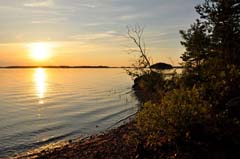Midsummer in Sweden: In Harmony with Nature
By Kathy Sykes
 “There are some who can live without wild things, and some who cannot. These are the delights and dilemmas of one who cannot. Like winds and sunsets, wild things were taken for granted until progress began to do away with them.”
“There are some who can live without wild things, and some who cannot. These are the delights and dilemmas of one who cannot. Like winds and sunsets, wild things were taken for granted until progress began to do away with them.”
–Aldo Leopold, A Sand County Almanac
June 21 is the longest day of the year and the start of summer. On the summer solstice, Earth is at its maximum axial tilt to the sun 23° 26′. And nature is in full bloom.
When this first day of summer arrives, I think of the time I spent in Sweden, where “Midsommar” is the most celebrated holiday and the sun never sets. I spent my first midsummer in Sweden when I was 16 with my grandfather Lars. He told me and other young girls to pick a bouquet of flowers and place them under our pillows in hopes of dreaming of our future spouses. Midsommar is special to me because it is spent outdoors, in the woods, with the land and nature.
We picked daises—and also pot marigolds for their yellow flowers. We listened to folk music and danced around the maypole, which is traditionally decorated with green plants while women wear wreaths of flowers in their hair. It is a time to also enjoy the seasons’ first strawberries, fresh herring, new potatoes—and some schnapps.
This year, I will be returning to my ancestral homeland and to the town where Lars was born to celebrate “Midsommar” with my many relatives. There is a strong connection to nature in Sweden. An ecological awareness runs deep in the Swedish gene pool. Swedes love the simple pleasures from the forest and sea, wild strawberries, chanterelles, herring and crayfish. And they recognize we can enjoy nature’s bounties only if we take steps to preserve and protect the environment.
My ancestors from Sweden and my parents instilled in me a love of nature. Others have left their mark on us all, like Aldo Leopold.
Leopold, a wildlife biologist and conservationist is best known for his book “A Sand County Almanac.” Considered by many to be the “father of wildlife ecology,” his writing taught me to “think like a mountain” and about the delicate balance of nature. He wrote: “The land ethic is the individual responsibility for the health of the land. Health is the capacity of the land for self-renewal. Conservation is our effort to understand and preserve this capacity.”
I will remember those words this Midsommar.
About the Author: Kathy Sykes is a Senior Advisor for Aging and Sustainability in the Office or Research and Development at the U.S. EPA. She grew up in Madison, Wi and has been working at the U.S. EPA since 1998.
Editor's Note: The opinions expressed in Greenversations are those of the author. They do not reflect EPA policy, endorsement, or action, and EPA does not verify the accuracy or science of the contents of the blog.

Well said. I hiked in the mountains of Sweden sometime around 1963-64 while on leave from the Navy and have very fond memories of that land.
The Good Force be with you!
Happy Summer, Kathy! It is good to be in harmony with nature because you feel the happiness of being with God’s wonderful creations.
Live forever and prosper!
Kathy,
Your blogpost makes me want to get on a plane and go to Sweden now! Definitely share your love nature.
Lina
Happy Summer, Kathy! It is good to be in harmony with nature because you feel the happiness of being with God’s wonderful creations.
Its only when we do not have access to such wonderful sights that we learn to appreciate them and are even willing to travel long distances to see them. Let us be appreciative of all that nature offers us because someday we might not even have this!